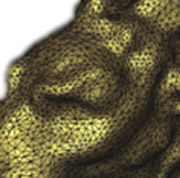
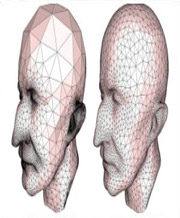
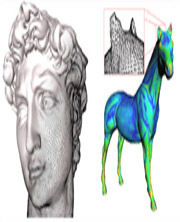
Digital Geometry Processing
Overview
This research contributes to the general IMSC vision by allowing the next wave of multimedia data, 3D geometry, to be transmitted efficiently on the web. Interactions with the rest of IMSC are mainly centered on our graphics expertise, for both hardware and software. Research on geometry processing will directly benefit the IMSC strategic plan as it promises to be extremely rewarding in terms of both educational and societal impacts. It will create a generation of researchers and professionals, with deep understanding of the diverse techniques from geometric modeling, computer graphics, signal processing, approximation theory and differential geometry required to advance the state of the art in digital geometry processing. Previous advances in digital signal processing (DSP), which formed the foundation of the first three waves of multimedia, are changing our society in many ways. From cellular phones to HDTV, scientific and technological progress in signal processing has led to successful industrial applications with substantial societal impact. The growth of digital geometry processing applications will similarly impact many areas of human activity, from entertainment to engineering, science and medicine.
Tech Summary
NSF Report (Year 7)
NSF Report (Year 8)
Poster
Laboratory
White Paper
Compression of 3D Representations
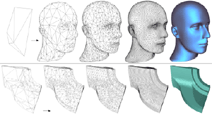
Our compression technique progressively transmits an arbitrary triangle mesh vertex by vertex. With (bottom) or without (top) the use of a metrics to drive the vertex ordering, we maintain good mesh quality and good rate-distortion ratio all along the transmission.
Lossless transmission of 3D meshes is a very challenging and timely problem for many applications, ranging from collaborative design to engineering. Additionally, frequent delays in transmissions call for progressive transmission in order for the end user to receive useful successive refinements of the final mesh. We present a novel, fully progressive encoding approach for lossless transmission of triangle meshes with a very fine granularity. A new valence-driven decimating conquest, combined with patch tiling and an original strategic retriangulation is used to maintain the regularity of valence. We demonstrate that this technique leads to good mesh quality, near-optimal connectivity encoding, and therefore a good rate-distortion ratio throughout the transmission.
Discrete Surface Processing
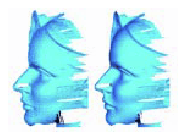
Complete set of tools for the analyzing, editing, or manipulation of 3D meshes. This includes fast denoising techniques like implicit fairing, accurate discrete differential-geometry operators on irregular meshes, or remeshing techniques to provide the user with semi-regular meshes with good aspect ratio triangles. The overall goal of this research is to go from DSP (for signals such as music, images, video) to DGP, for 3D objects now.
Parameterization and Remeshing of 3D Surfaces
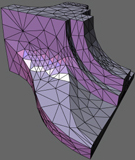
NASA has explicit plans to send a mobile vehicle, or rover, to explore the surface of the planet Mars. This rover is equipped with a pair of calibrated cameras. Transmitting these images pairs back to earth is extremely costly in terms of bandwidth. The goal of the project is to interpret the images locally, and to only transmit 3D models of objects of interest. The rover, while exploring his surrounding environment, acquires large collections of views. Each of these can be used for inferring the geometric description of its environment and/or merged together for inferring a more complete and compact description of the environment. The objective here is to reconstruct aggregate geometric models of the surface imaged by the spacecraft or the rover. We are more particularly interested in inferring high resolution geometric models from the collection of stereo maps acquired by the rover. Such geometric model will enable us to infer an accurate geometric description of the geological surfaces by merging the collection of patches acquired by the rover.